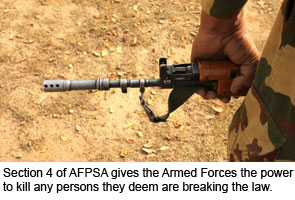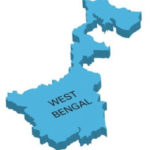Armed Forces (Assam- Manipur) Special Powers Act: An Overview (Part I)
INTRODUCTION
The Armed Forces (Special Powers) Act of 1958 (AFSPA) is one of the most
draconian legislations that the Indian Parliament has passed. Under this Act,
all security forces are given unrestricted and unaccounted power to carry out
their operations, once an area is declared disturbed. Even a non-commissioned
officer is granted the right to shoot to kill based on mere suspicion that it
is necessary to do so in order to “maintain the public order”.
draconian legislations that the Indian Parliament has passed. Under this Act,
all security forces are given unrestricted and unaccounted power to carry out
their operations, once an area is declared disturbed. Even a non-commissioned
officer is granted the right to shoot to kill based on mere suspicion that it
is necessary to do so in order to “maintain the public order”.
The AFSPA gives the armed forces wide powers to shoot, arrest and
search, all in the name of “aiding civil power.” It was first applied
to the North Eastern states of Assam and Manipur and was amended in 1972 to
extend to the entire seven sister states[1] in the north- eastern
region of India. The enforcement of the AFSPA has resulted in innumerable
incidents of arbitrary detention, torture, rape, and looting by security
personnel.[2]The Government of India
gives justification for this Act that it will stop the seceding of North East
states from the Indian Union.
search, all in the name of “aiding civil power.” It was first applied
to the North Eastern states of Assam and Manipur and was amended in 1972 to
extend to the entire seven sister states[1] in the north- eastern
region of India. The enforcement of the AFSPA has resulted in innumerable
incidents of arbitrary detention, torture, rape, and looting by security
personnel.[2]The Government of India
gives justification for this Act that it will stop the seceding of North East
states from the Indian Union.
HISTORICAL BACKGROUND
Through the centuries, the Himalayan hills and
valleys have bridged South, South East, and Central Asia. The great Hindu and
Muslim empires that reigned over the Indian sub-continent never extended east
of the Bhramaputrariver.India’s British colonizers were the first to break this
barrier. In the early 19th century, they moved in to check the Burmese
expansion into today’s Manipur and Assam. The British, with the help of the
then Manipur King, Gambhir Singh, crushed the Burmese imperialist dream and the
treaty of Yandabo was signed in 1828.[3] Under this treaty, Assam
became a part of British India and the British continued to influence the
political affairs of the region.
valleys have bridged South, South East, and Central Asia. The great Hindu and
Muslim empires that reigned over the Indian sub-continent never extended east
of the Bhramaputrariver.India’s British colonizers were the first to break this
barrier. In the early 19th century, they moved in to check the Burmese
expansion into today’s Manipur and Assam. The British, with the help of the
then Manipur King, Gambhir Singh, crushed the Burmese imperialist dream and the
treaty of Yandabo was signed in 1828.[3] Under this treaty, Assam
became a part of British India and the British continued to influence the
political affairs of the region.
This undue interference eventually led to the
bloody Anglo- Manipuri conflict of 1891.[4] The British reaffirmed
their position but were cognizant of the ferocious spirit of independence of
these people and did not administer directly but only through the King.
bloody Anglo- Manipuri conflict of 1891.[4] The British reaffirmed
their position but were cognizant of the ferocious spirit of independence of
these people and did not administer directly but only through the King.
After the departure of the British, the Kingdom
of Manipur was reconstituted as a constitutional monarchy on modern lines by
passing the Manipur Constitution Act, 1947.[5]
of Manipur was reconstituted as a constitutional monarchy on modern lines by
passing the Manipur Constitution Act, 1947.[5]
Elections were held under the new constitution.
A legislative assembly was formed. In 1949, Mr V P Menon, a senior
representative of the Government of India, invited the King to a meeting on the
pretext of discussing the deteriorating law and order situation in the state at
Shillong.[6] Upon his arrival, the King
was allegedly forced to sign under duress the merger agreement. The agreement
was never ratified in the Manipur Legislative Assembly. Rather, the Assembly
was dissolved and Manipur was kept under the charge of a Chief Commissioner.
There were protests, but the carrot-and-stick policy[7] launched by the Indian
Government successfully suppressed any opposition.
A legislative assembly was formed. In 1949, Mr V P Menon, a senior
representative of the Government of India, invited the King to a meeting on the
pretext of discussing the deteriorating law and order situation in the state at
Shillong.[6] Upon his arrival, the King
was allegedly forced to sign under duress the merger agreement. The agreement
was never ratified in the Manipur Legislative Assembly. Rather, the Assembly
was dissolved and Manipur was kept under the charge of a Chief Commissioner.
There were protests, but the carrot-and-stick policy[7] launched by the Indian
Government successfully suppressed any opposition.
At the beginning of the century, the inhabitants
of the Naga Hills, which extend across the Indo-Burmese border, came together
under the single banner of Naga National Council (NNC)[8], aspiring for a common
homeland and self-governance. As early as 1929, the NNC petitioned the Simon
Commission, which was examining the feasibility of future of self-governance of
India. The Naga leaders were adamantly against Indian rule over their people
once the British pulled out of the region. Mahatma Gandhi publicly announced
that the Nagas had every right to be independent. His assertion was based on
his belief in non-violence, he did not believe in the use of force or an
unwilling union.
of the Naga Hills, which extend across the Indo-Burmese border, came together
under the single banner of Naga National Council (NNC)[8], aspiring for a common
homeland and self-governance. As early as 1929, the NNC petitioned the Simon
Commission, which was examining the feasibility of future of self-governance of
India. The Naga leaders were adamantly against Indian rule over their people
once the British pulled out of the region. Mahatma Gandhi publicly announced
that the Nagas had every right to be independent. His assertion was based on
his belief in non-violence, he did not believe in the use of force or an
unwilling union.
Under the Hydari Agreement signed between NNC
and British administration, Nagaland was granted protected status for ten
years, after which the Nagas would decide whether they should stay in the Union
or not.[9] However, shortly after the
British withdrew, independent India proclaimed the Naga Territory as part and
parcel of the new Republic.
and British administration, Nagaland was granted protected status for ten
years, after which the Nagas would decide whether they should stay in the Union
or not.[9] However, shortly after the
British withdrew, independent India proclaimed the Naga Territory as part and
parcel of the new Republic.
The NNC proclaimed Nagaland’s independence. In
retaliation, Indian authorities arrested the Naga leaders. An armed struggle
ensued and there were large casualties on either side. The Armed Forces Special
Powers Act is the product of this tension.
retaliation, Indian authorities arrested the Naga leaders. An armed struggle
ensued and there were large casualties on either side. The Armed Forces Special
Powers Act is the product of this tension.
In 1975, some Naga leaders held talks with the
Government of India which resulted in what is known as the Shillong Accord.[10] The Naga leaders who did
not agree with the Shillong accord formed the National Socialist Council of
Nagaland (NSCN) and continue to fight for what they call,” Naga
sovereignty”.[11]
Government of India which resulted in what is known as the Shillong Accord.[10] The Naga leaders who did
not agree with the Shillong accord formed the National Socialist Council of
Nagaland (NSCN) and continue to fight for what they call,” Naga
sovereignty”.[11]
Much of this historical bloodshed could have
been avoided if the new India had lived up to the democratic principles
enshrined in its Constitution and respected the rights of the nationalities it
had taken within its borders. But in the over-zealous efforts to integrate
these people into the “national mainstream”, based on the dominant Brahminical
Aryan culture, much destruction has been done to the indigenous populations.
been avoided if the new India had lived up to the democratic principles
enshrined in its Constitution and respected the rights of the nationalities it
had taken within its borders. But in the over-zealous efforts to integrate
these people into the “national mainstream”, based on the dominant Brahminical
Aryan culture, much destruction has been done to the indigenous populations.
On 22 May 1958, a mere 12 days after the Budget
Session of Parliament was over, the Armed Forces (Assam-Manipur) Special Powers
Ordinance was passed.[12] A bill was introduced in
the Monsoon session of Parliament that year. Amongst those who cautioned
against giving such blanket powers to the Army included the then Deputy
Chairman of the RajyaSabha, (Upper House of the Indian Parliament), Mr P N
Sapru.[13] In a brief discussion
that lasted for three hours in the LokSabha and for four hours in the
RajyaSabha, Parliament approved the Armed Forces (Assam- Manipur) Special
Powers Act with retrospective from 22 May 1958.[14]
Session of Parliament was over, the Armed Forces (Assam-Manipur) Special Powers
Ordinance was passed.[12] A bill was introduced in
the Monsoon session of Parliament that year. Amongst those who cautioned
against giving such blanket powers to the Army included the then Deputy
Chairman of the RajyaSabha, (Upper House of the Indian Parliament), Mr P N
Sapru.[13] In a brief discussion
that lasted for three hours in the LokSabha and for four hours in the
RajyaSabha, Parliament approved the Armed Forces (Assam- Manipur) Special
Powers Act with retrospective from 22 May 1958.[14]
Read Part II HERE
About the Author:
Sanya Darakhshan Kishwar is a third year BSc.LLB. student from Central University of South Bihar, Gaya. She is currently interning at For the Sake of Argument.She is passionate about books and loves to read case laws in her free time.
[3]Treaty of Yandaboo, 24 February 1826,available at www.centralexcisehyderabad4.gov.in/documents/history/1826.PDF, last
[1]They are Assam,
Manipur, Tripura, Meghalaya, Arunachal Pradesh, Mizoram and Nagaland, also
known as the “seven sisters”.
Manipur, Tripura, Meghalaya, Arunachal Pradesh, Mizoram and Nagaland, also
known as the “seven sisters”.
[2]Armed Forces Special Powers Act: A study
in National Security tyranny, available at http://www.hrdc.net/sahrdc/resources/armed_forces.htm,
last seen on 02/06/2015
in National Security tyranny, available at http://www.hrdc.net/sahrdc/resources/armed_forces.htm,
last seen on 02/06/2015
[3]Treaty of Yandaboo, 24 February 1826,available at www.centralexcisehyderabad4.gov.in/documents/history/1826.PDF, last
seen on 02/06/2015
[4]Supra 2
[5]Manipur
Constitution Act,
available at http://www.satp.org/satporgtp/countries/india/states/manipur/documents/actsandordinances/manipur_state_constitution_act_1947.htm, last seen on
02/06/2015
Constitution Act,
available at http://www.satp.org/satporgtp/countries/india/states/manipur/documents/actsandordinances/manipur_state_constitution_act_1947.htm, last seen on
02/06/2015
[6]Supra 2
[7]Ibid
[8]Naga National Council, available athttp://en.wikipedia.org/wiki/Naga_National_Council, last seen on
02/06/2015
02/06/2015
[9]Supra 2
[10]Shillong
Accord of 1975
, available at http://en.wikipedia.org/wiki/Shillong_Accord_of_1975, last seen on
02/06/2015
Accord of 1975
, available at http://en.wikipedia.org/wiki/Shillong_Accord_of_1975, last seen on
02/06/2015
[11]Supra 2
[12]Armed
Forces (Special Powers)Act,1958,available at http://en.wikipedia.org/wiki/Armed_Forces_%28Special_Powers%29_Act,_1958, last seen on
02/06/2015
Forces (Special Powers)Act,1958,available at http://en.wikipedia.org/wiki/Armed_Forces_%28Special_Powers%29_Act,_1958, last seen on
02/06/2015
[13]Supra 2
[14]Supra 2





![Police Reforms – Priority ignored [Republished from Epilogue Press] Police Reforms – Priority ignored [Republished from Epilogue Press]](https://arguendo.co.in/wp-content/uploads/2017/07/41-150x150.jpg)

Leave a Reply